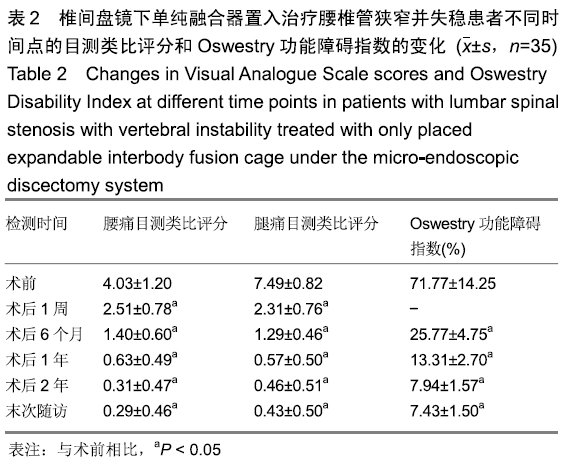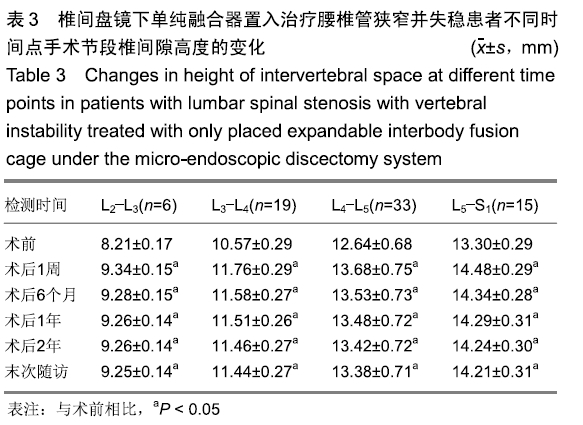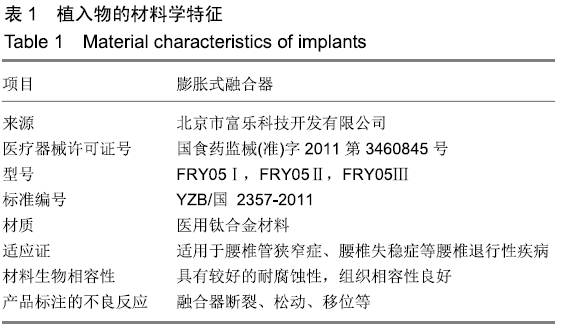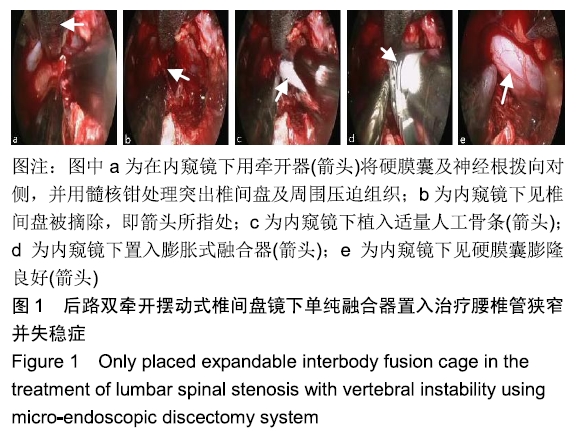[1] LIU J, DENG H, LONG X, et al. A comparative study of perioperative complications between transforaminal versus posterior lumbar interbody fusion in degenerative lumbar spondylolisthesis. Eur Spine J. 2016;25(5):1575-1580.
[2] STAATS PS, CHAFIN TB, GOLOVAC S, et al. Long-Term Safety and Efficacy of Minimally Invasive Lumbar Decompression Procedure for the Treatment of Lumbar Spinal Stenosis With Neurogenic Claudication: 2-Year Results of MiDAS ENCORE. Reg Anesth Pain Med. 2018;43(7):789-794.
[3] KAMSON S, TRESCOT AM, SAMPSON PD, et al. Full-Endoscopic Assisted Lumbar Decompressive Surgery Performed in an Outpatient, Ambulatory Facility: Report of 5 Years of Complications and Risk Factors. Pain Physician. 2017;20(2):E221-E231.
[4] OKA H, MATSUDAIRA K, TAKANO Y, et al. A comparative study of three conservative treatments in patients with lumbar spinal stenosis: lumbar spinal stenosis with acupuncture and physical therapy study (LAP study). BMC Complement Altern Med. 2018;18(1):19.
[5] MA XL, ZHAO XW, MA JX, et al. Effectiveness of surgery versus conservative treatment for lumbar spinal stenosis: A system review and meta-analysis of randomized controlled trials. Int J Surg. 2017;44:329-338.
[6] KORGE A, MEHREN C, RUETTEN S. Minimally invasive decompression techniques for spinal cord stenosis. Orthopade. 2019. doi: 10.1007/s00132-019-03732-7.
[7] RATHONYI GC, OXLAND TR, GERICH U, et al. The role of supplemental translaminar screws in anterior lumbar interbody fixation: a biomechanical study. Eur Spine J. 1998;7(5):400-407.
[8] BRODKE DS, DICK JC, KUNZ DN, et al. Posterior lumbar interbody fusion. A biomechanical comparison, including a new threaded cage. Spine (Phila Pa 1976).1997;22(1):26-31.
[9] 董健文,戎利民,蔡道章,等.单独置入扩张型椎间融合器再次修复复发性腰椎间盘突出症重建腰椎稳定性[J].中国组织工程研究与临床康复, 2008, 12(26):5015-5018.
[10] 张春霖,苗森,陈博光,等.双牵开摆动椎间盘镜技术治疗多节段腰椎间盘突出症[J].中华骨科杂志,2011,31(1):44-49.
[11] 张春霖,杨通宝,朱红鹤,等.比较两种前段膨胀椎间融合器在椎间盘镜下治疗腰椎不稳症的生物力学特点[J].中国组织工程研究,2012,16(9):1639-1642.
[12] SUK SI, LEE CK, KIM WJ, et al. Adding posterior lumbar interbody fusion to pedicle screw fixation and posterolateral fusion after decompression in spondylolytic spondylolisthesis. Spine (Phila Pa 1976). 1997;22(2):210-219; discussion 219-220.
[13] SHI SY, HUANG YS, HAO DJ. Therapeutic progress in lumbar spinal stenosis. Zhongguo Gu Shang. 2017;30(5):484-488.
[14] DOBRAN M, NASI D, GLADI M, et al. Clinical and psychological outcome after surgery for lumbar spinal stenosis: A prospective observational study with analysis of prognostic factors. Neurol Neurochir Pol. 2018;52(1):70-74.
[15] SETHI A, MUZUMDAR AM, INGALHALIKAR A, et al. Biomechanical analysis of a novel posterior construct in a transforaminal lumbar interbody fusion model an in vitro study. Spine J. 2011;11(9): 863-869.
[16] 刘通,刘辉,张建宁,等.微创神经根减压治疗腰椎管狭窄症的中远期疗效分析[J].中华神经外科杂志,2017,33(2):119-123.
[17] 黄开,杨金华.单侧入路双侧减压术和全椎板切除减压术治疗腰椎管狭窄症的临床疗效[J].江苏医药,2016,42(14):1576-1578.
[18] 兰家平,汤逊,徐永清,等.多节段开窗减压治疗退变性腰椎侧凸并多节段腰椎管狭窄[J].中国修复重建外科杂志,2014,28(8):960-964.
[19] 赵成,徐建广,连小峰,等.退变性腰椎管狭窄症临床治疗[J].国际骨科学杂志,2013,34(3):185-188.
[20] 钟波夫,徐中和,郭东明,等.可扩张型腰椎椎间融合器在退行性腰椎疾病中的应用评价[J].中国临床解剖学杂志, 2007,25(3):344-346.
[21] 尹志平,郑明锋,刘建卫,等.后路椎间融合术治疗伴失稳的腰椎间盘突出症[J].实用骨科杂志,2011,17(8):734-737.
[22] ALBEE FH. Transplantation of a portion of the tibia into the spine for Pott's disease. Apreliminary report. JAMA. 1911;57:885-886.
[23] HARRIS BM, HILIBRAND AS, SAVAS PE, et al. Transforaminal lumbar interbody fusion: the effect of various instrumentation techniques on the flexibility of the lumbar spine. Spine (Phila Pa 1976). 2004;29(4): E65-70.
[24] KETTLER A, NIEMEYER T, ISSLER L, et al. In vitro fixator rod loading after transforaminal compared to anterior lumbar interbody fusion. Clin Biomech (Bristol, Avon). 2006;21(5):435-442.
[25] 陈新,黄波,万海武.椎间植骨内固定治疗腰椎管狭窄症的优势[J].中国组织工程研究,2013,17(31):5705-5710.
[26] 杨洪佳,李荣文,周长友,等.精准减压与全椎板切除减压手术治疗腰椎管狭窄症的疗效对比[J].颈腰痛杂志,2018,39(6):761-764.
[27] ZDEBLICK TA, Phillips FM. Interbody cage devices. Spine (Phila Pa 1976). 2003;28(15 Suppl):S2-7.
[28] PHILLIPS FM. The argument for noninstrumented posterolateral fusion for patients with spinal stenosis and degenerative spondylolisthesis. Spine (Phila Pa 1976). 2004;29(2):170-172.
[29] 王文军,姚女兆,王鹿山,等.可膨胀性椎间融合器在腰椎退行性疾患治疗中的应用[J].中华骨科杂志,2007,27(12):889-892.
[30] 王宏波,燕军,刘世学,等.可膨胀性椎间融合器在腰椎退行性疾病治疗中的临床应用[J].中国医药导报,2011,8(35):180-181.
[31] KIMURA H, SHIKATA J, ODATE S, et al. Risk factors for cage retropulsion after posterior lumbar interbody fusion: analysis of 1070 cases. Spine (Phila Pa 1976). 2012;37(13):1164-1169.
[32] 王宇,穆尚强,梅继文,等.可膨胀椎间融合器治疗腰椎间盘轻度退变的有限元分析[J].吉林大学学报(医学版),2016,42(3):565-569,后插563.
[33] 梅继文,穆尚强.腰椎退行性疾病患者腰椎融合术中应用新型可膨胀式椎间融合器的效果观察[J].山东医药,2017,57(48):48-50.
[34] WONG HK, GOH JC, GOH PS. Paired cylindrical interbody cage fit and facetectomy in posterior lumbar interbody fusion in an Asian population. Spine (Phila Pa 1976). 2001;26(5):572-577.
[35] 张春霖,王若愚,李莹,等.腰椎失稳症患者腰椎间隙X线解剖分型及其临床意义[J].中华解剖与临床杂志,2015(6):488-493.
[36] WANG J, ZHOU Y, ZHANG ZF, et al. Disc herniation in the thoracolumbar junction treated by minimally invasive transforaminal interbody fusion surgery. J Clin Neurosci. 2014;21(3):431-435.
[37] MINAMIDE A, YOSHIDA M, IWAHASHI H, et al. Minimally invasive decompression surgery for lumbar spinal stenosis with degenerative scoliosis: Predictive factors of radiographic and clinical outcomes. J Orthop Sci. 2017;22(3):377-383.
[38] PHAN K, RAO PJ, KAM AC, et al. Minimally invasive versus open transforaminal lumbar interbody fusion for treatment of degenerative lumbar disease: systematic review and meta-analysis. Eur Spine J. 2015;24(5):1017-1030.
[39] 杨晋才,海涌,丁一,等.经皮内镜辅助下经椎间孔腰椎减压融合术治疗腰椎管狭窄症[J].中华医学杂志,2018,98(45):3711-3715.
[40] 汪翔,卜星平,吴小涛.微创单侧入路双侧减压固定与开放双侧减压固定治疗单间隙腰椎管狭窄症的疗效比较[J].临床外科杂志, 2018,26(12): 951-954.
|






